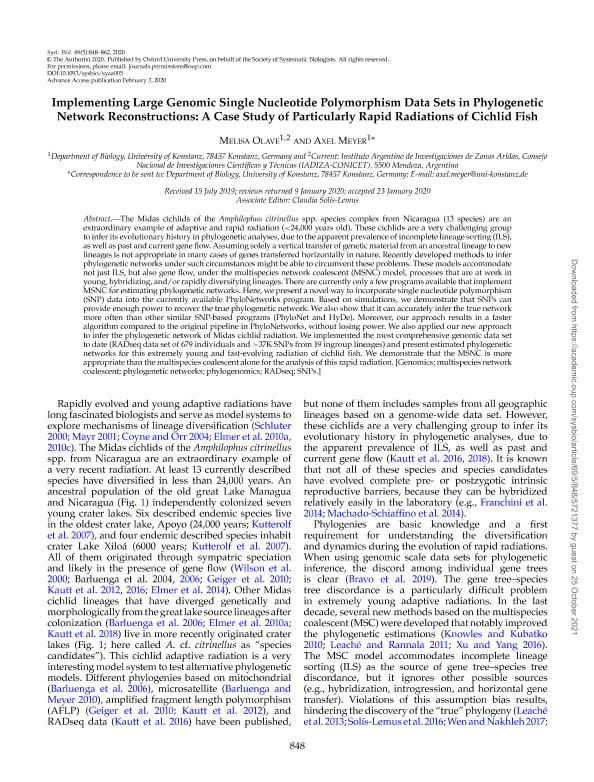Mostrar el registro sencillo del ítem
dc.contributor.author
Olave, Melisa

dc.contributor.author
Meyer, Axel
dc.date.available
2021-10-25T18:50:51Z
dc.date.issued
2020-02-03
dc.identifier.citation
Olave, Melisa; Meyer, Axel; Implementing large genomic single nucleotide polymorphism data sets in phylogenetic network reconstructions: A case study of particularly rapid radiations of cichlid fish; Oxford University Press; Systematic Biology; 69; 5; 3-2-2020; 848-862
dc.identifier.issn
1063-5157
dc.identifier.uri
http://hdl.handle.net/11336/144988
dc.description.abstract
The Midas cichlids of the Amphilophus citrinellus spp. species complex from Nicaragua (13 species) are an extraordinary example of adaptive and rapid radiation (<24,000 years old). These cichlids are a very challenging group to infer its evolutionary history in phylogenetic analyses, due to the apparent prevalence of incomplete lineage sorting (ILS), as well as past and current gene flow. Assuming solely a vertical transfer of genetic material from an ancestral lineage to new lineages is not appropriate in many cases of genes transferred horizontally in nature. Recently developed methods to infer phylogenetic networks under such circumstances might be able to circumvent these problems. These models accommodate not just ILS, but also gene flow, under the multispecies network coalescent (MSNC) model, processes that are at work in young, hybridizing, and/or rapidly diversifying lineages. There are currently only a few programs available that implement MSNC for estimating phylogenetic networks. Here, we present a novel way to incorporate single nucleotide polymorphism (SNP) data into the currently available PhyloNetworks program. Based on simulations, we demonstrate that SNPs can provide enough power to recover the true phylogenetic network. We also show that it can accurately infer the true network more often than other similar SNP-based programs (PhyloNet and HyDe). Moreover, our approach results in a faster algorithm compared to the original pipeline in PhyloNetworks, without losing power. We also applied our new approach to infer the phylogenetic network of Midas cichlid radiation. We implemented the most comprehensive genomic data set to date (RADseq data set of 679 individuals and >37K SNPs from 19 ingroup lineages) and present estimated phylogenetic networks for this extremely young and fast-evolving radiation of cichlid fish. We demonstrate that the MSNC is more appropriate than the multispecies coalescent alone for the analysis of this rapid radiation.
dc.format
application/pdf
dc.language.iso
eng
dc.publisher
Oxford University Press

dc.rights
info:eu-repo/semantics/openAccess
dc.rights.uri
https://creativecommons.org/licenses/by-nc-sa/2.5/ar/
dc.subject
Genomics
dc.subject
multispecies network coalescent
dc.subject
phylogenetic networks
dc.subject
phylogenomics
dc.subject.classification
Biología

dc.subject.classification
Ciencias Biológicas

dc.subject.classification
CIENCIAS NATURALES Y EXACTAS

dc.title
Implementing large genomic single nucleotide polymorphism data sets in phylogenetic network reconstructions: A case study of particularly rapid radiations of cichlid fish
dc.type
info:eu-repo/semantics/article
dc.type
info:ar-repo/semantics/artículo
dc.type
info:eu-repo/semantics/publishedVersion
dc.date.updated
2021-09-06T20:03:04Z
dc.journal.volume
69
dc.journal.number
5
dc.journal.pagination
848-862
dc.journal.pais
Reino Unido

dc.journal.ciudad
Londres
dc.description.fil
Fil: Olave, Melisa. Consejo Nacional de Investigaciones Científicas y Técnicas. Centro Científico Tecnológico Conicet - Mendoza. Instituto Argentino de Investigaciones de las Zonas Áridas. Provincia de Mendoza. Instituto Argentino de Investigaciones de las Zonas Áridas. Universidad Nacional de Cuyo. Instituto Argentino de Investigaciones de las Zonas Áridas; Argentina. University of Konstanz; Alemania
dc.description.fil
Fil: Meyer, Axel. University Of Konstanz; Alemania
dc.journal.title
Systematic Biology

dc.relation.alternativeid
info:eu-repo/semantics/altIdentifier/url/https://academic.oup.com/sysbio/advance-article/doi/10.1093/sysbio/syaa005/5721377
dc.relation.alternativeid
info:eu-repo/semantics/altIdentifier/doi/http://dx.doi.org/10.1093/sysbio/syaa005
Archivos asociados
